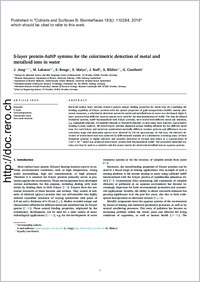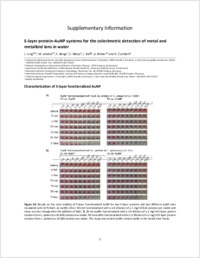S-layer protein-AuNP systems for the colorimetric detection of metal and metalloid ions in water
- Jung, J. Institute for Materials Science and Max Bergmann Center of Biomaterials, TU Dresden, Germany
- Lakatos, Mathias Photonic Nanosystems, Department of Physics, University of Fribourg, Switzerland
- Bengs, S. Department of Nuclear Medicine, Cardiovascular Gender Medicine, University Hospital Zurich, Switzerland
- Matys, S. Helmholtz-Institute Freiberg for Resource Technology, Freiberg, Germany
- Raff, J. Helmholtz-Zentrum Dresden Rossendorf, Institute of Resource Ecology, Dresden, Germany
- Blüher, A. School of Engineering Science, TU Dresden, Germany
- Cuniberti, G. Institute for Materials Science and Max Bergmann Center of Biomaterials, TU Dresden, Germany
-
01.11.2019
Published in:
- Colloids and Surfaces B: Biointerfaces. - 2019, vol. 183, p. 110284
English
Bacterial surface layer proteins (S-layer) possess unique binding properties for metal ions. By combining the binding capability of S-layer proteins with the optical properties of gold nanoparticles (AuNP), namely plasmonic resonance, a colorimetric detection system for metal and metalloid ions in water was developed. Eight S-layer proteins from different bacteria species were used for the functionalization of AuNP. The thus developed biohybrid systems, AuNP functionalized with S-layer proteins, were tested with different metal salt solutions, e.g. Indium(III)-chloride, Yttrium(III)-chloride or Nickel(II)-chloride, to determine their selective and sensitive binding to ionic analytes. All tested S-layer proteins displayed unique binding affinities for the different metal ions. For each S-layer and metal ion combination markedly different reaction patterns and differences in concentration range and absorption spectra were detected by UV/vis spectroscopy. In this way, the selective detection of tested metal ions was achieved by differentiated analysis of a colorimetric screening assay of these biohybrid systems. A highly selective and sensitive detection of yttrium ions down to a concentration of 1.67 × 10−5 mol/l was achieved with S-layer protein SslA functionalized AuNP. The presented biohybrid systems can thus be used as a sensitive and fast sensor system for metal and metalloid ions in aqueous systems.
- Faculty
- Faculté des sciences et de médecine
- Department
- Département de Physique
- Language
-
- English
- Classification
- Physics
- License
-
License undefined
- Identifiers
-
- RERO DOC 327745
- DOI 10.1016/j.colsurfb.2019.06.014
- Persistent URL
- https://folia.unifr.ch/unifr/documents/308130
Other files
Statistics
Document views: 90
File downloads:
- pdf: 225
- Supplementary material: 171

